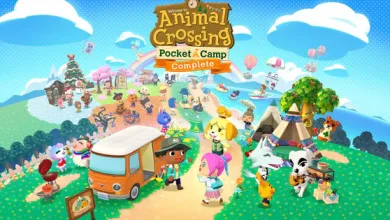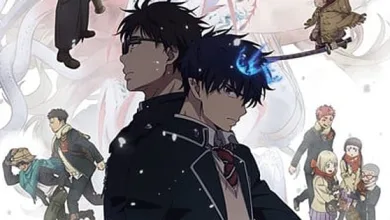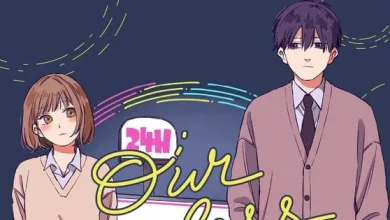The Horizon Volumes 1-3 Manhwa Review – Review

It’s not hard to see why JH’s three-volume manhwa The Horizon has been nominated for an Eisner Award. Something about the series screams “critical darling” in that most literary ways – everything about its bleakness, its metaphors, and its late-breaking religious imagery makes it feel like the sort of book disaffected teens are assigned to read in high school classes. It has the taste of “capital-L-Literature” about it.
Is that a bad thing? Not necessarily, and it doesn’t feel like JH is attempting a cynical bid for accolades. There’s a sincerity about the story that goes a long way toward making this readable and engaging, even if dark dystopias aren’t your preferred genre. But that same sincerity is almost a double-edged sword because JH is trying so hard to make their point about man’s inhumanity to man that by volume three things begin to feel overdone as if they’ve abruptly stopped trusting their readers to understand the message they’re attempting to send. This surfeit of symbolism kneecaps the plot, with the final thirty-odd pages spelling things out in a way that doesn’t feel wholly necessary. Mostly this is done with a heavy-handed use of Christian imagery, or more specifically, Christ iconography. It’s not the first time JH has used it; in volume two there’s a segment where The Girl is talking to a man suspended in what appears to be a cruciform pose, a man who later vanishes when she returns to help him. This dovetails with the message that The Boy receives from The Man as he teaches him to use a gun; he’s essentially put in a position to offer mercy, and by doing so he passes The Man’s test. The Girl’s offering to aid the hanging man similarly functions as a test of her goodness in a way that feels rather like a parable. Still, this is more subtle than what comes at the end, which involves crowns of thorns and a hand with stigmata reaching down to lift The Boy to Heaven; even if you enjoy symbolism, this is a little too on the nose.
As you have likely noticed, characters have no names in this story, which again adds to the parable-like feel of the narrative. We come into (and go out of) the story with The Boy – as a battle breaks out in his city, his mother hides him in an alley. When the sounds stop and he ventures out, it’s to a scene of unimaginable carnage: bodies are everywhere, including his mother’s. At first, The Boy (who looks to be somewhere between seven and ten) tries to put her brain back in her head, packing it in with mud, but eventually, he faces reality and begins to walk. He finds a school bus on the side of the road and sleeps in it, and when he wakes, The Girl is there. The two children continue to walk the seemingly endless highway, meeting up with a few adult men in various stages of symbolism: the man who has lost his mind, the former doctor (The Man) who is picking off marauders in a city in hopes of killing all the killers, and an old man who sits by the side of the road waiting for something he doesn’t understand. Through it all, the children survive because they have each other…until, abruptly, they don’t.
The story works with themes of innocence and murder. The Man’s entire goal is to put an end to war by assuming that anyone with a gun is someone willing to murder in almost the exact situation Buffy Sainte-Marie sang about in The Universal Soldier (“He’s the one who must decide who’s to live and who’s to die/And he never sees the writing on the wall”). As payment for healing the children’s wounds, inflicted by human traffickers they encounter on the road, he asks them to help him surveil the city, alerting him to anyone with weapons entering so that he can snipe them. The Girl, horrified, staunchly refuses to do so, but The Boy does help, eventually asking The Man to teach him how to use a gun. This is the major turning point in the story, because it is ultimately this knowledge that leads to the children’s fates, almost exactly as The Man said.
The two longest story arcs in the series are the children’s time with The Man and the flashback to how The Girl ended up on the school bus herself. The latter is heartrending because JH doesn’t indulge in the sort of symbolism that gets too heavy-handed in the rest of the series; it’s just a human tragedy playing out against a backdrop of an ending world. We don’t know where the story takes place – North America seems to be a safe bet, based on the school bus models – but the goal is to portray it as something that could happen anywhere. That is likely why the characters don’t have names; they could be anyone at any time, and we’re meant to see them as someone we know, or possibly ourselves. That could make the darker themes, which include suicide and the deaths of children, particularly difficult for some readers, so do be aware of that before picking the books up.
If you do read, however, pay close attention to the art. This is unquestionably the strongest element of the series – JH mostly draws in black and white but washes of warm or earth tones occasionally pervade the images, and the few color pages in volume three are striking and manifest a significant tonal change, even without paying attention to the plot. Black pages are rarely just black. They often hide barely-realized images happening in the darkness of characters’ memories.
The Horizon is not an easy story. It’s too heavy-handed as it reaches its conclusion, and its themes are dark, even for a dystopia. It feels like award bait although that is belied by the clear earnestness that comes through the pages, particularly at the end. THis is worth reading if you don’t mind bleakness and despair or are curious to see them used to make a point about warmongering and death. But it’s also not for everyone, and even with its mild bits of hope, it’s the kind of story that leaves you feeling a little empty when all is said and done.
Disclosure: Kadokawa World Entertainment (KWE), a wholly owned subsidiary of Kadokawa Corporation, is the majority owner of Anime News Network, LLC. Yen Press, BookWalker Global, and J-Novel Club are subsidiaries of KWE.
Source link
#Horizon #Volumes #Manhwa #Review #Review



